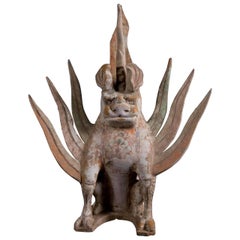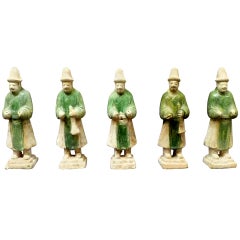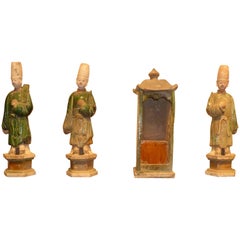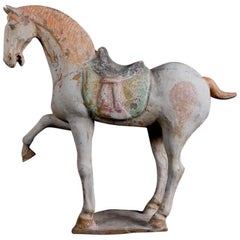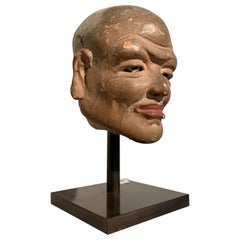Chinese Antiquities
1
416
to
68
177
42
416
416
416
416
229
116
2
74
13
3
17
2
3
1
3
2
1
336
137
65
41
37
727
474
416
171
68
1
Period: 18th Century and Earlier
Place of Origin: Chinese
Chimera (Pixiu) Terracotta Mythological Being - Tang Dynasty, China '618-907 AD'
Located in San Pedro Garza Garcia, Nuevo Leon
Magnificent Mythological Being "Chimera" with Human Face and Flaming Rays Halo. Orange Terracotta with Traces of Stucco and Painting.
This creature is commonly known as Pixiu. Fierc...
Category
15th Century and Earlier Tang Antique Chinese Antiquities
Materials
Terracotta
Set of Six Ming Dynasty Green Glazed Pottery Statue of Attendants
Located in Greenwich, CT
A set of six green glazed pottery statue of attendants, Ming dynasty 1368-1644.
Category
16th Century Ming Antique Chinese Antiquities
Materials
Pottery
Set of Refine Ming Dynasty Green Glazed Attendants and a Sedan Chair
Located in Greenwich, CT
A set of very refined green glazed attendants and one sedan chair, each with benevolent facial expression, beautiful colors and lines, Ming dynasty 1368-1644. Three glazed attendants...
Category
15th Century and Earlier Ming Antique Chinese Antiquities
Materials
Pottery
Massive Chinese Han Dynasty Sichuan Terracotta Pottery Horse, Oxford TL Tested
Located in Greenwich, CT
A massive Chinese Han dynasty Sichuan terracotta pottery figure of a horse
Han dynasty (206 BC-220 AD)
Powerfully modelled in a pose of alert attention, its strong neck and head po...
Category
15th Century and Earlier Han Antique Chinese Antiquities
Materials
Terracotta
Majestic Prancing Horse, Tang Dynasty, China '618-907 AD', TL Test by Kotalla
Located in San Pedro Garza Garcia, Nuevo Leon
Magnificent prancing horse in orange terracotta with traces of polychrome paint. Springing its right leg with a lively position and an expressive look. With a finely decorated saddle...
Category
15th Century and Earlier Tang Antique Chinese Antiquities
Materials
Terracotta
Chinese Painted Stucco Head of a Luohan, Song Dynasty, 11th Century, China
Located in Austin, TX
A remarkable Chinese life sized painted stucco head of a luohan, Song, Liao or Jin Dynasty, circa 11th century, China.
The amazingly life-like figure depicts a luohan (sometime spelled lohan), also known as an arhat, one of the original disciples of the Buddha. The elderly man has been molded in stucco with inset glass eyes and painted with idealized, if slightly exaggerated features.
The unidentified luohan sports a bald, or perhaps shaved, domed head above a bulging forehead, symbolizing his vast wisdom. The wrinkles in his furrowed brow, and creases around his eyes add to his realism. The learned man stares out wisely from deep set, heavily lidded inlaid glass eyes that catch the light.
The luohan has high cheekbones and a prominent jawline. His lips full and pursed as if about to speak. The corners of his mouth turned up ever so slightly in a faint smile, causing his gaunt cheeks to dimple charismatically. A series of dots above the upper lip indicate he may originally have sported a mustache of real hair.
This life sized head with extremely realistic features fits into a very narrow time frame of Chinese Buddhist art. Perhaps the most recognized group of large, finely molded Chinese luohan...
Category
15th Century and Earlier Antique Chinese Antiquities
Materials
Glass, Stucco
18th Century Chinese Ginger Jars
Located in Esbeek, NL
Beautiful set of Chinese ginger jars
18th century or earlier.
Category
18th Century Antique Chinese Antiquities
Materials
Porcelain
Magnificent Tang Dynasty Prancing Horse, TL Test by ASA Francine Maurer
Located in San Pedro Garza Garcia, Nuevo Leon
Magnificent Prancing Horse in Orange Terracotta with Traces of Yellow Painting. With its Anterior right Leg raised. TL Test by ASA Francine Maurer Laboratory. It was during the "gol...
Category
15th Century and Earlier Tang Antique Chinese Antiquities
Materials
Terracotta
Tang Dynasty Sancai Glazed Pottery Camel, TL Tested
Located in Austin, TX
An evocative Chinese Tang dynasty (618 to 906 AD) sancai glazed pottery model of a braying camel. The camel is well modeled, standing foursquare upon a rectangular plinth, neck raised, head thrown back, and mouth open in either a defiant, or triumphant, bray.
Although sancai means "three color", this particular camel is glazed with only two colors - mostly in amber, with patches of straw glaze mimicking the large patches of fur along the camel's legs, humps, head and neck.
TL tested...
Category
15th Century and Earlier Tang Antique Chinese Antiquities
Materials
Pottery
16th-17th Century Chinese Pine Center Table with Carvings and Decorations
Located in Kastrup, DK
16th-17th century center table from 'Shanxi Province, China with 1 drawer.
Made of pine and with original polychrome lacquer.
Original condition. Rare piece of furniture.
Category
17th Century Ming Antique Chinese Antiquities
Materials
Elm
Archaic Chinese Bronze Ritual Vessel, Gui, Early Western Zhou, 11th century BCE
Located in Austin, TX
A stunning and rare Chinese archaic bronze gui, a type of ritual bronze vessel used to hold grain, either for feasting, or for making offerings ...
Category
15th Century and Earlier Archaistic Antique Chinese Antiquities
Materials
Bronze
Very Elegant Tang Dynasty Dignitary in Orange Terracotta, China '618-907 AD'
Located in San Pedro Garza Garcia, Nuevo Leon
Very elegant terracotta dignitary in blue and red robes standing with the hands joined at the chest. He wears a blue headdress with a bird at its center. Orange Terracotta
This gorg...
Category
15th Century and Earlier Tang Antique Chinese Antiquities
Materials
Terracotta
Three Ancient Terracotta Sculptures, China Ming Period
Located in Roma, IT
This Chinese terracotta group of figures is made up of three figures of Chinese dignitaries in glazed green and ocher terracotta on hexagonal bases and removable heads.
From the d...
Category
16th Century Antique Chinese Antiquities
Materials
Terracotta
18th Century Blue and White Porcelain and Silver Chinese Jug, Kangxi, 1662-1722
Located in Delft, NL
18th century blue and white porcelain and silver Chinese jug, Kangxi, 1662-1722
18th century blue and white porcelain Chinese jug??With silver handle an...
Category
18th Century Antique Chinese Antiquities
Materials
Silver
18th Century Chinese Miniature Double-Gourd Vases, Kangxi
Located in Delft, NL
18th Century Chinese Miniature Double-Gourd Vases, Kangxi
3 small double-gourd miniature vases in "milk blood" white porcelain with iron-red and gold paint made in the period of Kan...
Category
18th Century Antique Chinese Antiquities
Materials
Porcelain
6 Elegant Ming Dynasty Court Attendants in Glazed Terracotta, China 1368-1644 AD
Located in San Pedro Garza Garcia, Nuevo Leon
A fine set of a six court attendants as in the Forbidden City of Beijing, elegantly dressed in a Green & Red Daopao – a traditional men’s formal attire from the Ming Dynasty dated 1368-1643 A.D. – with glazed robes and Red Pigment remains in their hat and belts. They stand in an honorary posture atop a red plinth, some with orifices in their hands, where spirit objects were placed to comfort or satisfy the deceased. The heads are detachable, as often seen on the larger figures from this period.
They are accompanied by a Certificate of Authenticity, and Certificate of Expertise by Jean-Yves Nathan - a leading authority specialized in Far East Archaeology from the CEDEA (The European Confederation of Art Experts).
Burial figurines of graceful dancers, mystical beasts, and everyday objects reveal both how people in early China approached death and how they lived. Since people viewed the afterlife as an extension of worldly life, these figurines, called mingqi, sometimes referred as “spirit utensils” or “vessels of ghosts” disclose details of routine existence and provide insights into belief systems over a thousand-year period.
The Ming dynasty was the ruling dynasty of China – then known as the Empire of the Great Ming – for 276 years (1368–1644 AD). Founded by Chu Yuan-chang, the rebel leader that was successful in removing the mongols from the throne. Chinese control was re-asserted in China and eastern Asia. Literature became more important, schools were created, and the justice system was reformed. The Ming dynasty is described by some as "one of the greatest eras of orderly government and social stability in human history,” was the last imperial dynasty in China ruled by ethnic Han Chinese.
The practice of burying ceramic objects with the deceased went into decline from the 10th to the 14th Century AD. There was a revival in placing miniature representations of glazed terracotta objects such a furniture, food offerings, horses, miniature statues...
Category
15th Century and Earlier Ming Antique Chinese Antiquities
Materials
Terracotta
Elegant Han Dynasty Terracotta Warrior - China '206 BC - 220 AD'
Located in San Pedro Garza Garcia, Nuevo Leon
Impressive terracotta warrior representing a banner bearer gripping a wooden staff with his hands (dematerialized through the ages); his gaze is ser...
Category
15th Century and Earlier Han Antique Chinese Antiquities
Materials
Terracotta
Chinese Liao Dynasty Amber Glazed Stoneware Strap Handle Ewer, 11th Century
Located in Austin, TX
A lovely Chinese amber glazed pottery pouring vessel, Liao Dynasty (907 to 1125 AD).
The vessel featuring a globular body with an elongated neck sligh...
Category
15th Century and Earlier Tang Antique Chinese Antiquities
Materials
Stoneware
Impressive Terracotta Funerary Procession - Ming Dynasty, China '1368-1644 AD'
Located in San Pedro Garza Garcia, Nuevo Leon
Impressive Funeral Ensamble of 10 Terracotta Glazed Figures in green and caramel colors depicting a votive procession with a palanquin, his four carriers, a horse, a stableman, two musicians, and an offering carrier.
This ensemble is accompanied by a Certificate of Authenticity, and Certificate of Expertise by Jean-Yves Nathan - Specialist in Asian Arts for the CEDEA (The European Confederation of Art Experts).
Burial figurines of graceful dancers, mystical beasts, and everyday objects reveal both how people in early China approached death and how they lived. Since people viewed the afterlife as an extension of worldly life, these figurines, called mingqi, sometimes referred as “spirit utensils” or “vessels of ghosts” disclose details of routine existence and provide insights into belief systems over a thousand-year period.
The Ming dynasty was the ruling dynasty of China – then known as the Empire of the Great Ming – for 276 years (1368–1644 AD). Founded by Chu Yuan-chang, the rebel leader that was successful in removing the mongols from the throne. Chinese control was re-asserted in China and eastern Asia. Literature became more important, schools were created, and the justice system was reformed. The Ming dynasty is described by some as "one of the greatest eras of orderly government and social stability in human history,” was the last imperial dynasty in China ruled by ethnic Han Chinese.
The practice of burying ceramic objects with the deceased went into decline from the 10th to the 14th Century AD. There was a revival in placing miniature representations of glazed terracotta objects such a furniture, food offerings, horses, miniature statues...
Category
15th Century and Earlier Ming Antique Chinese Antiquities
Materials
Terracotta
16th Century Stone Pillar, Sianxi, China
Located in New York, NY
A carved stone pillar from Shanxi, China, circa 1560.
Mounted on a heptagonal wood base.
Category
16th Century Ming Antique Chinese Antiquities
Materials
Stone
Tang Dynasty Court Official in Sancai Glazed Robes, China '618-907' - TL Tested
Located in San Pedro Garza Garcia, Nuevo Leon
A Tang dynasty sancai (three color) glazed pottery model of a Taoist official, TL tested by Ralf Kotalla - worldwide oldest private laboratory specialized for genuine thermoluminesce...
Category
15th Century and Earlier Tang Antique Chinese Antiquities
Materials
Terracotta
Superb Set of 5 Elegant Court Attendants, Ming Dynasty, 1368-1644 AD TL Tested
Located in San Pedro Garza Garcia, Nuevo Leon
A stunning set of 5 graceful terracotta figurines from the Ming Dynasty '1368-1644' AD. These elegant attendants are standing on a yellow glazed lotus flower over a high hexagonal green plinth and wear fine robes in matching green and yellow glazes. The unglazed areas have pigmented colors in red, black and white. Each is carrying essential offerings for the royal family. The head is detachable as often seen on the larger figures from this period. Meticulously detailed facial expressions have been hand-painted.
Condition: Mint, finely preserved glaze and pigment, undamaged and no repairs.
Provenance: Ex. Danish Collection.
This set is guaranteed authentic and comes with a Certificate of Authenticity and TL Test from Laboratory Kotalla in Germany (The Oldest Thermoluminescence Testing Laboratory in the World).
Dimensions: Average 54 H cms
Burial figurines of graceful dancers, mystical beasts, and everyday objects reveal both how people in early China approached death and how they lived. Since people viewed the afterlife as an extension of worldly life, these figurines, called mingqi, sometimes referred as “spirit utensils” or “vessels of ghosts” disclose details of routine existence and provide insights into belief systems over a thousand-year period.
The Ming dynasty was the ruling dynasty of China – then known as the Empire of the Great Ming – for 276 years (1368–1644 AD). Founded by Chu Yuan-chang, the rebel leader that was successful in removing the mongols from the throne. Chinese control was re-asserted in China and eastern Asia. Literature became more important, schools were created, and the justice system was reformed. The Ming dynasty is described by some as "one of the greatest eras of orderly government and social stability in human history,” was the last imperial dynasty in China ruled by ethnic Han Chinese.
The practice of burying ceramic objects with the deceased went into decline from the 10th to the 14th Century AD. There was a revival in placing miniature representations of glazed terracotta objects such a furniture, food offerings, horses, miniature statues...
Category
15th Century and Earlier Ming Antique Chinese Antiquities
Materials
Terracotta
Large Superb Naturalistic Modeled Standing Camel, Tang Dynasty Oxford TL Tested
Located in Greenwich, CT
A large superbly and naturalist modeled standing camel, Tang dynasty 618-907, come with Oxford authentication TL test certificate, Oxford test numbers 102s49.
Category
15th Century and Earlier Tang Antique Chinese Antiquities
Materials
Terracotta
Monumental Han Dynasty Terracotta Horse - TL Tested - China, '206 BC–220 AD'
Located in San Pedro Garza Garcia, Nuevo Leon
A massive pottery horse with separately made head and tail, standing on all fours and striding with its right hoof forward. Extended snout ends in parted lips showing teeth beneath i...
Category
15th Century and Earlier Han Antique Chinese Antiquities
Materials
Terracotta
Monumental Buddha Torso White Marble Sculpture - Tang Dynasty China 618-907 AD
Located in San Pedro Garza Garcia, Nuevo Leon
Beautiful and impressive early Tang white marble sculpture of headless Buddha, dressed in an elegant pleated toga. China. 618-907 AD. A true collectors piece.
This magnificent piece...
Category
15th Century and Earlier Tang Antique Chinese Antiquities
Materials
Marble
Ming Dynasty Celestial Deity Head Carved in Stone - China '1368-1644 AD'
Located in San Pedro Garza Garcia, Nuevo Leon
Wonderful celestial deity head with a jovial expression in stone with a finely engraved cap. It is mounted on a custom lucite base.
This piece is accompanied by a Certificate of Authenticity, and Certificate of Expertise by Jean-Yves Nathan - Specialist in Asian Arts for the CEDEA (The European Confederation of Art Experts).
The Ming dynasty was the ruling dynasty of China – then known as the Empire of the Great Ming...
Category
15th Century and Earlier Ming Antique Chinese Antiquities
Materials
Stone
Han Dynasty Green Glazed Covered Storage Jar
Located in Austin, TX
A wonderful Han Dyansty (206 BC-200 AD) storage vessel. The circular body set upon three legs and fitted with a lid. The entirety covered in heavy leaded green glaze, imitating bronz...
Category
15th Century and Earlier Han Antique Chinese Antiquities
Materials
Pottery
Lady Guanyin Bodhisattva Gilded Wood Carving - Ming Dynasty, China 1368-1644 AD
Located in San Pedro Garza Garcia, Nuevo Leon
Magnificent Lady Guanyin Bodhisattva seated in Royal Relaxation pose hand-carved in Gilded Wood with traces of paint still visible.
This expressi...
Category
15th Century and Earlier Ming Antique Chinese Antiquities
Materials
Wood
Chinese Blue and White Porcelain Salt Cellars, Kangxi
Located in Delft, NL
Chinese porcelain salt cellars, Kangxi (1662-1722)
2 Chinese porcelain salt cellars with 3 rims and inside the double blue ring a scene of sever...
Category
Late 17th Century Antique Chinese Antiquities
Materials
Porcelain
Chinese Tang Dynasty Pottery Court Lady
Located in Austin, TX
Painted pottery figure of an opulent Chinese court woman with up-swept hair and standing in a simply draped robe from the Tang Dynasty (618-907 AD). Her beauty is illuminated by the ...
Category
15th Century and Earlier Tang Antique Chinese Antiquities
Materials
Pottery
Chinese Tang Dynasty Painted Pottery Model of a Camel
Located in Austin, TX
A powerfully sculpted Chinese Tang Dynasty pottery model of a camel. The camel is portrayed in a walking stance, long neck extended, with head held high, mouth askew chewing cud. The...
Category
15th Century and Earlier Tang Antique Chinese Antiquities
Materials
Pottery
Eastern Han Dynasty Terracotta Model of a Paper Mill , China '206BC - 220AD'
Located in San Pedro Garza Garcia, Nuevo Leon
Slab pottery constructed Model of a Paper Mill, in Green and Cream Color Glazed Terracotta having a peaked roof – open walled form with a mechanical pounder and a large round storage container. Light blue-green mottled glazed surface with some iridescence patina to the glaze. The Iridescence is a refraction of the layers on the glass that produces multicolor hues & metallic luster, and only develops after one thousand years of being buried in the ground. An unquestionable mark of antiquity, impossible to falsify.
Han Dynasty, dated 206 B.C-220 A.D.
Condition: Excellent, wear commensurate with age, an unusual example.
This fantastic piece is accompanied by a Certificate of Authenticity.
Sculptural effigies of domesticated animals were often interred in the tombs of nobility and elite members of the social hierarchy. Models like this one were made to represent everything from simple goat or pig pens to the most elaborate towers and palaces. Because very few ancient Chinese buildings have survived intact, these models, along with descriptions from ancient texts, give a good representation of what the buildings might have looked like.
Burial figurines of graceful dancers, mystical beasts, and everyday objects reveal both how people in early China approached death and how they lived. Since people viewed the afterlife as an extension of worldly life, these figurines, called mingqi, sometimes referred as “spirit utensils” or “vessels of ghosts” disclose details of routine existence and provide insights into belief systems over a thousand-year period. For the first time in Chinese history, we have images of rural and daily life during the Han in the form of contemporary records...
Category
15th Century and Earlier Han Antique Chinese Antiquities
Materials
Terracotta
Extremely Rare Late Shang Dynasty Inlaid Bronze Gu Vessel
Located in Austin, TX
Of classic trumpet form, with a round, splayed foot, narrow, waisted body and wide, flaring mouth.
Two sets of large, well defined fanged and horned taotie masks cast in high relief...
Category
15th Century and Earlier Archaistic Antique Chinese Antiquities
Materials
Jade, Malachite, Bronze
Antique 18th Century Chinese Fencai porcelain plate, Kangxi
Located in Delft, NL
Antique 18th century Chinese Fencai porcelain plate, Kangxi
With decoration in the middle of a vase with flowers surrounded in octangle line with flo...
Category
18th Century Antique Chinese Antiquities
Materials
Porcelain
Expressive Court Lady in Orange Terracotta - Wei Dynasty, China '386-557 AD'
Located in San Pedro Garza Garcia, Nuevo Leon
Lovely sitting lady from the Imperial Court with original polychrome paint in orange terracotta.
This piece is accompanied by a the following documents:
- Certificate of Expertise by Jean-Yves Nathan - Specialist in Asian Arts for the
- Certificate of Authenticity
Mingqi in the Six Dynasties...
Category
15th Century and Earlier Antique Chinese Antiquities
Materials
Terracotta
Ming Dynasty Chinese Countryside Villa - TL Tested
Located in San Pedro Garza Garcia, Nuevo Leon
Extremely rare Chinese model of a countryside villa for the royal courtiers and ministries of the Ming Dynasty -1368-1644 AD- showing three guest houses and one main entry. The villa is surrounded by a cuadrangular wall painted with bucolic scenes of garden, mountains, and bamboo forests. The roof tiles are glazed in green enamel with yellow finials – as the ones in the forbidden city – typical from the Ming epoch. Truly a museum piece. The doors swivel and are painted in ochre. State of preservation: impeccable mint condition with original paintings, all of the original parts are complete, except for one house which is missing part of the plinth (broken during transport). Each part has been tested for authenticity, consisting of eight separate TL tests...
Category
15th Century and Earlier Ming Antique Chinese Antiquities
Materials
Terracotta
Chinese Six Dynasties Pottery Model of an Armored Horse, 3rd-4th Century, China
Located in Austin, TX
An extremely rare Chinese painted pottery model of an armored horse, Six Dynasties period (220-581 AD), TL tested by Oxford Authentication.
The stocky ...
Category
15th Century and Earlier Antique Chinese Antiquities
Materials
Pottery
Fine Chinese Han Dynasty Pottery Figure of a Standing Woman
Located in Greenwich, CT
Fine Chinese Han Dynasty pottery figure of a standing woman, elegant and finely sculpted statue, Han Dynasty 206 BC-220 AD.
Category
15th Century and Earlier Han Antique Chinese Antiquities
Materials
Terracotta
Shakyamuni, the Original Buddha Sculpted in Schist Stone, Originally from a Cave
Located in San Pedro Garza Garcia, Nuevo Leon
Shakyamuni, the original Buddha sculpted in schist stone. Originally from a cave.
Sui dynasty '589-618' AD
Gautama Buddha, also known as Siddhartha or simply the Buddha. He was an a...
Category
15th Century and Earlier Antique Chinese Antiquities
Materials
Schist
Han Dynasty Gray Pottery Figure of a Female Kneeling Long Sleeve Dancer
Located in Austin, TX
A stunningly quiet and elegant Western Han dynasty (206 BCE - 9 CE) high fired gray pottery figure of a female long sleeved dancer.
The young dancer is portrayed in a moment of quie...
Category
15th Century and Earlier Han Antique Chinese Antiquities
Materials
Earthenware
Jin Dynasty Cizhou Ware Crouching Tiger Pottery Pillow, 12th-century, China
Located in Brooklyn, NY
Chinese Jin Dynasty 12th Century Cizhou Ware Crouching Tiger Pottery Pillow .Tiger pillow, Jin dynasty, 12th century (circa 1150)
The pillow is assembled ...
Category
15th Century and Earlier Ming Antique Chinese Antiquities
Materials
Ceramic
Monumental "Bigger Than Life Size" Wooden Bodhisattva
Located in San Pedro Garza Garcia, Nuevo Leon
Imposing figure of Bodhisattva sitting in a royal pose with a beautiful serene expression, with semi close eyes expressing beatitude, in very well carved robes and pearl strings on t...
Category
Late 17th Century Antique Chinese Antiquities
Materials
Wood
18th Century Iron-Red and Gilt, Chinese Miniature Porcelain Jug, Kangxi
Located in Delft, NL
18th Century Iron-Red and Gilt, Chinese Miniature Porcelain Jug, Kangxi
An Iron-Red and Gilt (Milk and blood porcelain), Chinese miniature porcelain ju...
Category
18th Century Antique Chinese Antiquities
Materials
Porcelain
Ancient China Monumental Stone Ram Han Dynasty, 206BC-220AD
Located in South Burlington, VT
China, a large votive model of a stone ram, Han dynasty (206BC-220AD)
Dimensions: 45cm, 18 inches high and 65cm, 26 inches length and 25cm, 10 inches wi...
Category
15th Century and Earlier Han Antique Chinese Antiquities
Materials
Limestone
Important Chinese Ancient Bronze Money Tree, 25BC-220AD
Located in South Burlington, VT
China, Ancient Bronze “Money Tree” Yaoqian Shu with original pottery base, Han dynasty (25 BCE – 220 CE)
Dimensions: 155cm, 62 inches high
A sculpted terracotta pottery base in the form of a tortoise with attendants and inserted with five individual bronze pole segments with twenty four individual hanging bronze open work money “branches” attached in tiers, four per tier and topped with a figure of a bronze phoenix as apex most bearing varying degrees of malachite and azurite encrustation from ancient burial.
Important Description Details:
Pottery "tortoise" base: 14.5" high and 11" wide
Bronze sections:
7pcs pole bronze sections approximately 8" length each
1pc top "phoenix" bronze section approximately 7" high and 6" wide
20 pcs long bronze hanging wings approximately 10" long and 5" wide each
4 pcs short bronze hanging wings (near top) approximately 7" long and 4" wide each
Total 32 pcs with ancient green and blue azurite patina.
Catalog reference: Schneible Fine arts catalog - 35 Years Collecting Treasures- Number 11p. 28 (see photos)
Provenance: Provenance: Private family collection formerly exhibited “Asia Week” New York City, Fuller Building, Zabriskie Gallery, 2008.
History of money trees:
In the late Han Dynasty tombs...
Category
15th Century and Earlier Han Antique Chinese Antiquities
Materials
Bronze
Fine Chinese Han Dynasty Pottery Figure of a Standing Man
Located in Greenwich, CT
Chinese Han Dynasty pottery figure of a standing man, an elegant and finely sculpted statue, Han Dynasty 206 BC-220 AD.
Category
15th Century and Earlier Han Antique Chinese Antiquities
Materials
Terracotta
China Ancient Stone Entertainer, Han Dynasty 200 AD
Located in South Burlington, VT
China an ancient limestone figure of an Entertainer replete with hands holding tambourines and a top a drum, -for the afterlife- , Han dynasty 206 BC...
Category
15th Century and Earlier Han Antique Chinese Antiquities
Materials
Limestone
Massive Neolithic Vessel
Located in Chicago, IL
This pot most likely came from what is now modern Kansu, the corridor west of the Yellow River and in the T'ao River Valley region of northwest China and east Mongolia. The Hsia Chia...
Category
15th Century and Earlier Antique Chinese Antiquities
Materials
Earthenware, Ceramic
Important Ancient Chinese Effigy Pug Dog, Ming Dynasty 1368-1644
Located in South Burlington, VT
China, a carving of a canine “Pug”, Ming Dynasty, 1368-1644 CE
Dimensions: 38 cm, 15” High
Photographs taken indoors and out of doors for your viewing pleasure.
The hand carved limestone beast shown on its haunches with naturalistic joyful expression and a well defined compact head, ears, noes, eyes, feet, and tail parted to one side on reverse with distinctive collar ornament seated four square on a thick base all-over showing a weathered surface from significant age.
Formerly exhibited “Asia Week” New York City, Fuller Building, Hutton Gallery 2006.
Provenance: ex collection luoyang, Henan Province, China.
Includes custom display base as shown
Catalog reference: 35 years collecting 35 treasures, Number 35, p.76 (photo)
In ancient China, it is a well-known fact that several types of small dogs were bred and were favored pet gifts between emperors and kings including Lion Dogs, Pekingese and Lo-sze breeds. Some Lo-sze are pictured wearing collars with bells a frequent combination fancied by European royalty of the seventeenth and eighteenth centuries. Lo-sze or pugs were prized for their compact body, good bones, flat face, square jaw, short coat, curled tail, side set back ears, and temperate disposition.
History:
Placing stone animals in important tombs can be traced back at least to the Qin Dynasty (221-206 BCE), some two thousand years ago. In ancient times, stone animals and human figures placed before imperial tombs symbolized royal power and privilege in addition to decorative functions.
The first Ming tomb...
Category
15th Century and Earlier Ming Antique Chinese Antiquities
Materials
Limestone
Chinese Stone Tabletop Altar, c. 1600
Located in Chicago, IL
This tabletop altar with scrolled edges, a scalloped apron, and turned legs from China's Shanxi province is a rare find. We conservatively estimate it to be late Ming dynasty (circa ...
Category
Early 17th Century Ming Antique Chinese Antiquities
Materials
Limestone
Pair of Antique Hand-Carved Wood Temple Corbels from 18th Century, China
Located in Yonkers, NY
A pair of Chinese 18th century hand-carved wooden temple corbels. Each corbel features detailed animals, shells, and other adornments among openwork fol...
Category
18th Century Antique Chinese Antiquities
Materials
Wood
Han Cocoon Shaped Vessel
Located in Coral Gables, FL
Han dynasty, China, circa 200 BC to 2 AD.
Category
15th Century and Earlier Other Antique Chinese Antiquities
Materials
Earthenware
Han Cocoon-Shaped Vessel
Located in Coral Gables, FL
Han dynasty, China, circa 200 BC-2 AD.
Category
15th Century and Earlier Other Antique Chinese Antiquities
Materials
Earthenware
Han Cocoon-Shaped Vessel
Located in Coral Gables, FL
Han Dynasty, China, circa 200 BC-2 AD.
Category
15th Century and Earlier Other Antique Chinese Antiquities
Materials
Earthenware
Chinese Dian Culture Large Gold Cuff, circa 2nd Century BC, Southern China
Located in Austin, TX
A large and impressive solid high karat gold cuff from the Dian Kingdom, circa 2nd century BC, modern day Yunnan Province, China.
.
This striking cuff is crafted from hand hammered ...
Category
15th Century and Earlier Han Antique Chinese Antiquities
Materials
Gold
Pair of Tang Dynasty Painted Pottery Soldiers
Located in Austin, TX
A well modelled pair of Tang dynasty painted pottery soldiers.
The warriors portrayed standing, dressed in form fitting, elaborate layered Armor with fitted helmets. The breastplate...
Category
15th Century and Earlier Tang Antique Chinese Antiquities
Materials
Pottery
Han Dynasty, Antique Chinese Pottery Hu Jar
Located in Sampantawong, TH
Antique Chinese pottery Hu jar decorated with bands of raised lines and a pair of monster masks on the shoulder.
Age: China, Han Dynasty, 206 B.C. - A.D. 220
Size: Height 45.5 C.M. ...
Category
15th Century and Earlier Antique Chinese Antiquities
Materials
Pottery
Chinese Tang Dynasty Painted Pottery Model of a Horse
Located in Austin, TX
A Chinese Tang dynasty pottery model of a horse. The majestic animal is portrayed standing foursquare on a rectangular plinth, head slightly turned. A saddle and saddle blanket are d...
Category
18th Century and Earlier Tang Antique Chinese Antiquities
Materials
Pottery
Recently Viewed
View AllMore Ways To Browse
Lapis Asian Figurine
Bactrian Stone
Antique Viking Pendant
Chinese Opium Pipes
Antique Wooden Hibachi
Haniwa Heads
Greco Bactrian
Desert Samurai
19th Century Burmese Thai Buddha
Samurai Hat
Antique Chinese Corbels
Khmer Torso
Used Polo Boots
Vintage Asian Parasol
Han Dynasty Amphora
Antique Pig Figurine
Antique Pig Figurines
Horse Hair Ceramic Art
